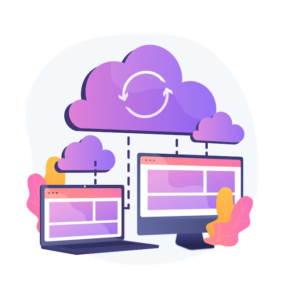Adopting a Cloud Platform Solution refers to implementing a comprehensive infrastructure and service framework that leverages cloud technologies. It enables organizations to harness the benefits of scalability, flexibility, cost optimization, and streamlined operations, empowering them to innovate and thrive in the digital landscape.
In recent years developers are deploying microservices-based applications in the cloud instead of traditional monolithic applications. Because microservices architecture provides better scalability, flexibility, and fault tolerance.
Microservices architecture in the cloud allows developers to break complex applications into small independently scalable services to provide more agility and faster response time.
In this blog, we’ll explore the best practices for deploying microservices in the cloud. We will explore important aspects of microservices deployment that include service discovery, load balancing, scaling, and more.
We will also explore cloud platform for middle east to meet the unique needs of the region. This blog will help you deploy robust and scalable microservices. Read till the end for some valuable insights.
Best Practices for Deploying Microservices in the Cloud

Service Discovery
Imagine a big city with all similar-looking buildings housing thousands of businesses without any brand boards. Without a map or reliable directory, it would be impossible for you to find the service you are looking for. In the same way, service discovery is important for microservices in the cloud. Service discovery connects different microservices to work together seamlessly.
Service Discovery Best Practices
There are different methods of navigating a business in a big city. Likewise, service discovery has different methods to navigate and connect different microservices.
DNS-based Service Directory: In this method, service names are mapped out in front of their IP addresses. So services can query and find other services, just like an online phone directory.
Client-side Service Directory: In this method, each available service registers itself to the service discovery server. So clients can easily find and communicate with the required service.
Comparison of Cloud Platforms
Here is a comparison of cloud application development services. Google Cloud platform has its own service discovery service called Cloud DNS. Cloud DNS creates DNS records and makes it easier to deploy microservices in google cloud. On the other hand, Amazon has its own Route 53. It creates DNS records and routes microservices making it easier to deploy Java microservices in AWS.
Nife is another cloud platform that provides a seamless service discovery solution that integrates with both Google Cloud and AWS. Nife’s service discovery module automatically registers and updates microservices information in the service registry. It locates and enables communication between microservices.
Load Balancing
Load balancing is another important part of microservices architecture. With multiple microservices applications working independently with varying loads, it becomes important to carefully manage these microservices for a streamlined workflow. Load balancing acts as a traffic controller and distributes the incoming request to all the available service instances.
Load Balancing Best Practices
Just as there are different methods for controlling traffic there are different practices for load balancing in a microservices architecture.
Round Robin: In this load-balancing method requests are distributed among services in a rotating fashion. Services are queued and each new request is transferred to services instances following their position in the queue.
Weighted Round Robin: In this method, each service is given a weight, and requests are served proportionally among all the services.
Least Connections: In this load-balancing method requests are directed according to the load on service instances. Requests are directed towards the services handling the least amount of load.
Comparison of Cloud Platforms
Here is a comparison of two renowned cloud application development services. Google Cloud platform has its own load balancing services which provide HTTP(S) Load Balancing, TCP/UDP Load Balancing, and Internal Load Balancing, and makes it easier to deploy microservices in google cloud. On the other hand, Amazon also has its own Elastic Load Balancing (ELB). It provides different types of load balancing options to handle load efficiently making it easier to deploy Java microservices in AWS.

Nife is another cloud platform that offers full load-balancing options. It can integrate with both google cloud and AWS. Nife leverages effective load-balancing techniques for microservices architecture for an efficient and streamlined workflow.
Scaling
Scaling is another important aspect of microservices deployment, especially in the case of cloud platforms for Middle East region. Microservices break down complex applications into smaller manageable services. The workload on each of these services can increase dramatically in case of increased demand. To manage these loads it is important to have a scalable infrastructure. Here are some primary scaling approaches.
Horizontal Scaling: In this practice, more microservices are added to handle increasing load.
Vertical Scaling: In this practice, the resources of microservices are increased. In this way, microservice can handle increasing demand with
Nife: Simplifying Microservices Deployment in the Cloud | Cloud Platform Solution

Developers are always seeking efficient and streamlined solutions for deploying microservices. That’s where Nife comes in, a leading platform for cloud application development services. It simplifies the deployment of microservices and provides a wide range of features tailored according to the needs of developers. With Nife, you can enjoy a unified experience whether you want to deploy microservices in google cloud or deploy Java microservices in AWS.
By leveraging Nife’s Cloud Platform for Middle East, developers can address the unique needs of that region. Nife’s strength is its seamless integration of service discovery, load balancing, and scaling capabilities. Nife provides a service discovery mechanism to enable communication between microservices. Its seamless load balancing automatically distributes traffic across microservices. While automatic scaling ensures proper usage of cloud resources according to demand.
To experience the power of Nife and simplify your microservices deployment, Visit nife.io
Discover Nife’s Cloud Platform for Efficient Deployment of Microservices
Conclusion:
Are you looking to deploy microservices in the cloud? Discover the best practices for developers in this comprehensive article. Explore how to deploy microservices in Google Cloud and AWS, utilizing their cloud application development services.
Learn about service discovery, load balancing, and scaling techniques to ensure seamless communication and optimal resource utilization.
Discover how the Cloud Platform for Middle East caters to the unique needs of developers in the region. Experience the power of Nife cloud platform solution, simplifying microservices deployments and empowering developers to build exceptional applications. Revolutionize your cloud journey today with Nife’s comprehensive suite of tools and services.






